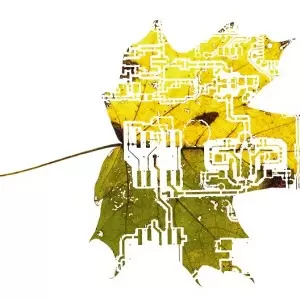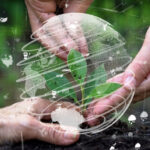
Humanity has always engineered the environment around us. From the earliest days of wetland drainage and the need to acquire fresh water, to keep it flowing and keep it clean enough to drink, building cesspits to take away our waste and to stop pollution of vital waterways, we have always strived to maximize our sanitation and living conditions in order to expand and survive.
Sanitation is a large part of our civil evolution; without it, we would succumb more often to water-borne disease and illness - raising our mortality rates and lowering our quality of life. Therefore, we've always needed to find bigger and better ways of taking away our sewage, cleaning our water and harnessing natural or artificial water supplies for our health and environment. Since the industrial revolution in the 19th century we have needed to prevent businesses and individuals from polluting the environment with harmful substances. The modern environmental engineer is dedicated to keeping our air and water clean of pollutants and promoting good health (1) and these days, protection against radioactive and toxic materials too; they also study the potential effects of climate change and other environmental factors on the infrastructure (2).
Shortage of Engineers
There is presently a shortage of STEM graduates coming out of our colleges and universities right across the western world and engineering is one of the core areas that has suffered the most. This means that with a good degree, there is a high likelihood of getting a good job fresh out of your studies. A master's degree then may be unnecessary for most people, but for the especially gifted who may be looking towards greater responsibility in future or to move towards the very top of the field, it may be advisable to do an advanced degree - all the way to the PhD. If you choose to go that high, you may be more involved in business or government policy than the “hands on” approach of the job of the bachelor's graduate. Environmental engineering is an applied science.
Learn more about environmental engineering careers.
Read about environmental engineering degrees.
History of Environmental Engineering
Ancient World to Industrialisation
How far back were humans aware of the need for sanitation? It is generally believed that the first civilisation to have express concern for what happens to sewage waste and to develop more complex ways of moving it, and the first designers of sewer systems as we would understand them, was Republican Rome. Certainly, archaeologists interested in the study of sanitation will often turn to the largest Republic and later Empire the ancient world has ever known in order to understand urban development amongst other things, but the process goes back further than this to the Harappan Civilisation of the Indus Valley (3). Their remarkable achievements included grid-planned cities with the most elaborate network of water supply and waste disposal. Larger houses had their own wells and the poorer abodes made do with communal water, but these were all connected - just as the sewer systems taking the waste away were connected (4, p7-15). Surprisingly, they also had public toilets and baths. Cleanliness was of the utmost importance.
By the time we reach the Roman Republic, technology had developed into elaborate systems of water and sewage transportation for which we know the ancient world was famous. We have all heard about the aqueduct systems across the empire; the Romans knew that drought was a possibility in the Mediterranean climate that dominated most of the land of the empire so they built massive stone networks to carry water from areas where it was abundant to areas that could suffer in a drought. The Romans did not invent them, but they did enhance the technology and create monuments that far exceeded the examples they emulated (5). The massive sewer system that still exists beneath the city of Rome today was used to drain the marshes to create farmland as well as to remove sewage from the houses and businesses in the city; it was built as early as the 7th century BC, way before the Imperial era (6).
Both the aqueducts and the sewers allowed Rome to expand their cities to the immense sizes that still hold us in awe today, so it is no surprise that we do not really see much change for some 1400 years after the fall of Rome. The beginning of environmental engineering arguably came with a great public work in London in the 19th century (1). Joseph Bazalgette was charged with overseeing the building work of a massive sewer system after what historians now call The Great Stink. The city was in the grip of a cholera epidemic with the conduits providing the basis of the sewer system then proving inadequate, leading to raw sewage pumped into the River Thames that also provided the majority of the city's drinking water (7). Prime Minister Benjamin Disraeli extracted a �3.5m budget from Parliament for the project. The completed project replaced all the pipes and improved the existing network, dramatically improving the city's health, ending the cholera epidemic (a disease that never returned to London after that) and leading to similar programmes in industrialised cities throughout the world. This was a time where free market capitalism was subject to no environmental regulation and was not encouraged to think about the people's health.
20th to 21st Century
The next leap forward would make us question the role of some pesticides used in farming methods. Rachel Carson was a highly qualified biologist, but not a famous one, when she released her book Silent Spring. It was a careful and lengthy study of the role of pesticides and their impact on the environment since the birth of intensive farming following World War II (8). Carson presented evidence that delicate ecologies were being lost and could be lost in the future without the study of the role of certain pesticides, particularly DDT, and the correct action taken if proven harmful. At the time, the chemical was proving vital in the fight against malaria yet it was also proving damaging to crops and other wildlife too. Most alarmingly, Carson (and those who followed her work) noted that while DDT use was expanding, malaria-carrying mosquitoes were building up a resistance to the substance (9).
Her book made governments take notice of the dangerous of industrial activity -President John F. Kennedy and his successor Johnson both focused heavily on a growing concern for the environment during their presidencies. They set the wheels in motion and the EPA came into being in 1970 during the Nixon era (10) who proclaimed the 1970s a “decade of environmental transformation”, enacting legislation to cover air and water quality. Couple this with environmental awareness in the general population and the (then) growing understanding of the effects of climate change meant that environmental engineering was born in this era. Since then, environmental legislation has sought to define environmental standards on clean water, air quality, solid waste disposal and pollution management (toxic and radioactive) - at state and national level (11), and to define international standards. We are using an ever-increasing number of chemicals with toxic waste and the remit of the environmental engineer is to keep the environment safe for humans and for other forms of life.
Types of Environmental Engineering
Management of Solid Waste
We are, and have been for a very long time, a consumer society and consumer societies generate a lot of waste. Food packaging, white goods, broken electronics and everything else that we dispose of is considered solid waste. In the western world, we recycle a lot of solid material, but not nearly enough and new technologies will bring problems of their own in reclamation, recycling or otherwise disposal of those material. In the developing world where recycling is limited or non-existent, this is expected to be a major problem as they seek to industrialise to the point that they too can join the developed world (12, p1-2). Climate change is now a large factor in how fast these countries can develop. Environmental engineers of the future will be expected to provide answers and strategies for this form of waste disposal.
Landfill sometimes remains the only option for some materials, and how we manage these sites and the materials that go into them is something that environmental engineers work with every day. Recycling is big business and we are learning how to recycle material (and to do so safely) in order to better utilise the resources we have.
Water Supply
As the human population expands, we need access to an ever-increasing supply of water - whether that is drinking water, to keep our crops nourished so we can eat, to preserve local wildlife and the delicate ecosystem, water is vital to life. Over the last decade, we have been aware of the limits of water acquisition and retention. California has suffered drought, putting an enormous strain on water supplies in the south-western USA (13). Europe too has suffered both drought (14) and flooding (15) and both scenarios bring problems of their own for Environmental Engineering. Drought affects food supply and increases fire risks in urban areas; flooding also affects food supply and the economy; businesses cannot open and local and national governments have a large bill for a clean-up operation, as well as putting an enormous strain on public services.
Environmental engineers already play a huge part in managing water supply - in droughts and in floods and outside of disaster areas, identifying where there are problem areas not getting enough water - irrigation or inadequate facilities.
Management of Water Waste
Environmental engineers ensure the smooth running of supplying us with water, and of taking it away from our homes and businesses. As mentioned earlier, humans have always needed to remove waste water as quickly and effectively as possible; it is good for our health and for the environment and today we produce so much waste water from our toilets, from our showers and baths, from swimming pools, from washed clothes and dishes - and that's just home use. We produce a lot of waste industrially too and disposal of these substances do not necessarily follow the same process; dangerous materials can leak into the environment and our drinking water so it needs careful handling.
The majority of this water goes to waste treatment facilities is filtered, processed and pumped back to us after a rigorous cleaning process (16). Much of what you drink and use has been used over and over again for the same things and it's thanks to experts in this area that our water is so clean. They also tackle water pollution in all its forms.
Air Pollution Management
Air pollution has been a big issue since the 1960s and many countries introducing a Clean Air Act or equivalent. Some of the world's largest cities were big polluters until then; over the decades, the remit of the Environmental Engineer has changed. It used to be control and management of toxic materials and their effects on the environment - the 1980s was a big problem for Acid Rain (17); professionals in the air pollution category were fundamental to raising awareness of the problems cause and advising on legislation to reduce the output of relevant gases (sulphur dioxide and nitrogen dioxide) into the atmosphere. Today, acid rain still has the potential to cause harm, but levels have been reduced by 70% in some parts of the world (18).
Today, they are also concerned with greenhouse gases such as carbon dioxide in attempting to reduce the global output so that we may limit the temperature rise in the future. This is not their only area though; industrial pollutants are not limited to greenhouse gas emissions. Read more on air quality.
The Future of Environmental Engineering
The future is likely to see more technological development, population growth and a greater need for enough food for our growing population, housing and facilities to cater to our growing needs, new farming methods and so on. These are likely to see more areas needing management to avoid pollution or ecological damage; we will see new potential contaminants as well as a need to change conditions in some areas to cope with the changing climate. There will be an even greater need for environmental engineers to help us deal with the potential problems that this future will bring.
Sources
- http://www.livescience.com/48390-environmental-engineering.html
- http://www.bls.gov/oes/current/oes170000.htm
- https://www.jstor.org/stable/124907?seq=1
- https://www.academia.edu/5937322/Chapter_2_Sanitation_and_wastewater_technologies_in_Harappa_Indus_valley_civilization_ca._26001900_BC
- http://www.ancient.eu/aqueduct/
- http://www3.iath.virginia.edu/waters/Journal4Hopkins.pdf
- http://www.waterhistory.org/histories/london/
- http://orgprints.org/22934/7/22934.pdf
- http://www.sciencedaily.com/releases/2014/02/140224204808.htm
- http://www2.epa.gov/laws-regulations
- http://www.euractiv.com/sustainability/european-drought-cuts-food-outpu-news-514331
- https://www.gov.uk/government/news/winter-weather-uk-government-response
- http://water.worldbank.org/shw-resource-guide/infrastructure/menu-technical-options/wastewater-treatment
- http://www.epa.gov/region1/airquality/nox.html
- Guide to Parasitology - November 19, 2018
- Deserts as Ecosystems and Why They Need Protecting - November 19, 2018
- Conservation: History and Future - September 14, 2018
Related Articles
Featured Article

Environmental Planning, Design, and GIS





